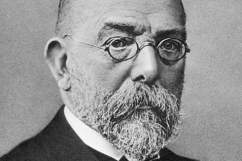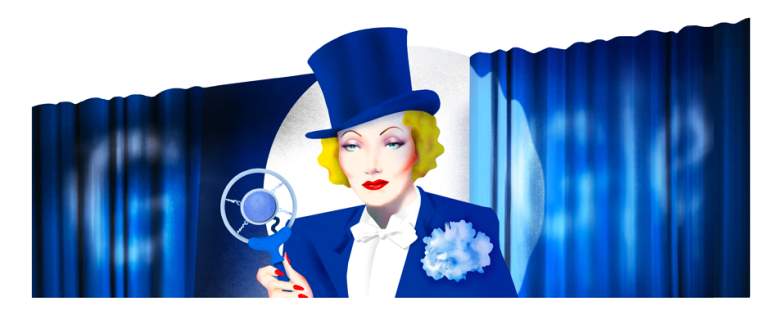
Marlene Dietrich is being celebrated with a Google Doodle.
Marlene Dietrich, an iconic actress who starred on screen during Hollywood’s Golden Age and later on stage, is being celebrated with a Google Doodle on what would have been her 116th birthday.
Dietrich, born in Germany, is also known for her humanitarian efforts and performances for Allied troops during World War II, which earned her the U.S. Medal of Freedom and French Légion d’Honneur.
“Dietrich was more than a femme fatale with an unforgettable voice. Ever the risk-taker, she turned pat notions about femininity upside down, donning a tuxedo and top hat in her part as a sultry nightclub dancer in Morocco, and wearing men’s silk suits offscreen,” Google says.
Sasha Steinberg, a drag performer under the name Sasha Velour, designed the Doodle. “She was a wild original!” Despite the pressures of the time, she followed her own course, especially in terms of politics and gender. As a drag queen, that’s particularly inspiring to me. Plus, she just had this power to her…in every role she’s mysterious and strong, brilliant. That’s what I aspire to be when I step on the stage,” Velour said.
Here’s what you need to know:
1. Marlene Dietrich Was Born in 1901 in Germany, Where She Studied Violin & Theater as a Teen
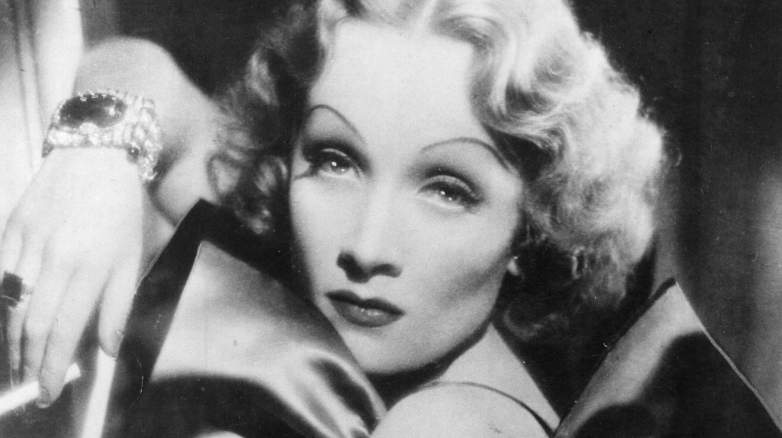
GettyMarlene Dietrich.
She was born Marie Magdalene Dietrich in Schöneberg, Germany, in what is now Berlin, on December 27, 1901. Dietrich was the youngest of two daughters to Wilhelmina and Louis Dietrich, according to the biography “Marlene Dietrich: Life and Legend.” Her sister, Elizabeth, was a year older than her.
According to the New York Times, her father, a police lieutenant and former soldier, died when she was just 9. Her mother was the daughter of a “well-to-do watch merchant,” according to the Times.
“Marie Magdalene attended a private school in Weimar, studied French and took violin lessons, hoping for a concert career,” the Times said in her obituary. “But when she was 18, a hand injury threatened that dream and she decided to try dramatics, contracting her two given names to Marlene because her family disapproved of acting.”
When she was 19, she enrolled in Max Reinhardt’s drama school and began her acting career, landing small roles on stage and in German films. Her career began to take off in the late 1920s, as she took on increasingly important roles in German films and was likened to Greta Garbo, according to the Times.
2. Her Breakthrough Came in ‘The Blue Angel’ in 1929, Which Led to a Hollywood Contract With Paramount Pictures
Dietrich landed her breakthrough role in 1929 when she was cast to star in the 1930 film “The Blue Angel” as Lola Lola, a cabaret singer. “Falling in Love Again,” which you can see her performing above, would become her signature song.
The film was directed by Josef von Sternberg, who discovered Dietrich. After its success, she followed von Sternberg to the United States, signing a contract with Paramount Pictures. Von Sternberg would direct seven Hollywood films with Dietrich, according to the New York Times. The films were released between 1930 and 1935. They included “Morocco,” which was released in 1930, and earned Dietrich her only Academy Awards nomination.
She also starred in “Dishonored,” “Shanghai Express,” “Blonde Venus,” “Song of Songs,” “The Scarlet Express” and “The Devil Is a Woman.”
“In many ways they seem apart from, and perhaps in advance of, their time. The near-abstract quality of the images — throbbing, sinuous, ever-shifting patterns composed in black and white and all the gradations in between — anticipates an American avant-garde movement that would not flower until the late 1940s; the self-consciously preposterous narratives, with their wild melodramatic coincidences and exotic settings, would find their echo in the 1960s, in the camp posturing of “underground” filmmakers like George Kuchar and Jack Smith,” Dave Kehr wrote in the Times in 2012.
Dietrich left Paramount in 1936 to star in her first color film, “The Garden of Allah,” and the British film “Knight Without Armour,” but both failed at the box office and damaged her film career. She never again regained her on-screen success, but continued to appear in films until the late 1950s, including in movies directed by Alfred Hitchcock, Fritz Lang, Orson Welles and Billy Wilder.
After the war, became more well known as a stage performer, working as a highly paid cabaret artist at major cities around the world. She also had a music career, working alongside arranger Burt Bacharach.
“What she does is neither difficult nor diverting, but the fact that she does it at all fills the onlookers with wonder,” Francis Wyndham wrote about her performances. “It takes two to make a conjuring trick: the illusionist’s sleight of hand and the stooge’s desire to be deceived. To these necessary elements (her own technical competence and her audience’s sentimentality) Marlene Dietrich adds a third—the mysterious force of her belief in her own magic. Those who find themselves unable to share this belief tend to blame themselves rather than her.”
3. The Nazi Party Tried to Get Her Back to Germany, but She Instead Renounced Her Citizenship & Began Helping Jews & Dissidents Escape Her Former Home
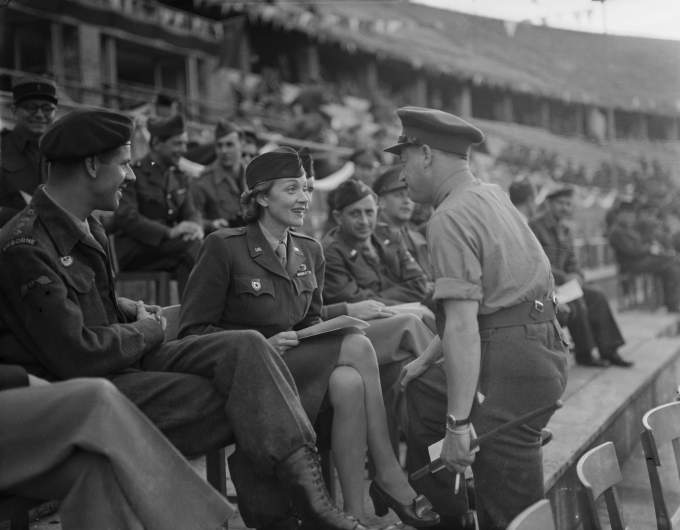
GettyGerman born American actress Marlene Dietrich among the spectators at the Olympic Stadium in Berlin to watch the first inter-allied athletic meeting of Berlin’s occupying troops, 25th September 1945. Dietrich was on a tour of Germany, entertaining allied troops stationed there.
Dietrich was approached by the Nazi Party in the late 1930s, according to CNN. Hitler wanted her to return to Germany and perform in propaganda films in her homeland. But she refused. According to CNN, she was an antifascist who opposed what was happening in Germany.
“She saw the rise of the Third Reich in her home country and could not stand it. She was so upset about the betrayal she felt the Third Reich was doing to her homeland,” Kate Lemay, the curator of a Dietrich exhibit at the National Portrait Gallery in Washington, told CNN earlier this year.
Instead of returning to Germany, Dietrich renounced her citizenship and became an American citizen. She joined director Billy Wilder and other Germans in an effort to help raise money for Jews and dissidents who were trying to flee from Germany.
Dietrich also joined the American war effort, selling war bonds and performing on USO tours for troops.
She called her efforts, “the only important thing I’ve ever done.”
Dietrich said Hitler wanted her to be his mistress, according to her Washington Post obituary.
“I turned him down,” she said. “Maybe I should have gone to him. I might have saved the lives of 6 million Jews.”
4. She Was Bisexual & a Glamour Icon Known for Her Unconventional Style That Defied Gender Norms
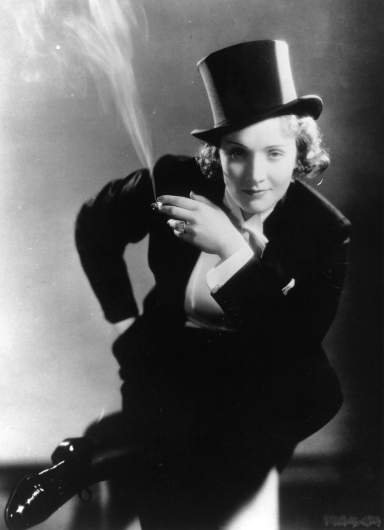
Marlene Dietrich.
Dietrich was bisexual and known for her iconic style, which was glamorous and defied gender norms.
Kenneth Tynan, a critic, wrote, “Her manner was that of “a serpentine lasso whereby her voice casually winds itself around our most vulnerable fantasies. She has sex but no positive gender. Her masculinity appeals to women and her sexuality to men,” according to her New York Times obituary.
A friend, Maurice Chevalier, told the Times after her death, “Dietrich is something that never existed before and may never exist again. That’s a woman.”
Dietrich once said, “Glamour. is assurance. It is a kind of knowing that you are all right in every way, mentally and physically and in appearance, and that, whatever the occasion or the situation, you are equal to it.”
According to the Times, “In clothes, she was a trend setter. Both on screen and off, she often wore trousers and mannish costumes. By proving that a woman could still look feminine in such clothes, she established ‘the Dietrich silhouette,’ emphasizing trimness and inconspicuous hips and bust.”
Dietrich had a string of affairs with both men and women, including Gary Cooper, John Gilbert, James Stewart, John Wayne, Mercedes de Acosta and possibly Greta Garbo.
5. Dietrich, Who Was Married & Had a Daughter, Suffered From Many Ailments During Her Later Years & Died in 1992 at 90
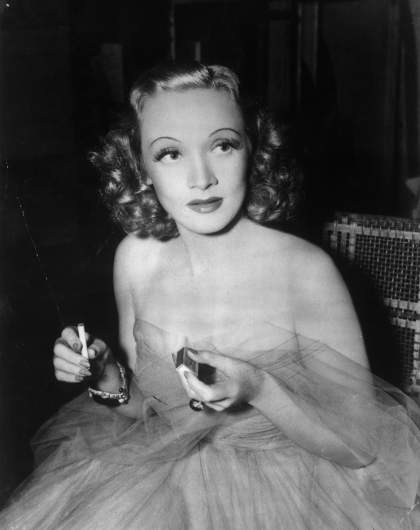
Marlene Dietrich.
Dietrich died in 1992 at the age of 90. She married her husband, Rudolph Sieber, a production assistant on one of her films, in 1924, according to the New York Times. She never divorced her husband and “—he remained a friend, an adviser, and a dependent for decades—he did not interfere with her numberless affairs,” according to the New Yorker. He died in 1976.
Dietrich and Sieber had a daughter, Maria, born in 1925, who was also an actress.
“She was deeply devoted to her family, worked hard to advance her daughter’s career and helping her daughter and son-in-law financially. To be with her family, Miss Dietrich lived in Manhattan when not touring, but in 1972 she moved her chief residence from Park Avenue to Paris, where she lived in a four-room apartment on Avenue Montaigne, in the Eighth Arrondissement,” according to the New York Times.
The Washington Post says in her obituary that she lived in seclusion in Paris at th etime of her death.
Dietrich suffered from illness and other ailments in her later years, she survived cervical cancer in 1965 and suffered from poor circulation in her legs. She became dependent on painkillers and alcohol after suffering falls on stage that caused serious injuries in the 1970s.
In 1975 when she fell off a stage while performing in Australia, breaking her thigh. She spent the final 11 years of her life bedridden and only allowing visits from close friends and family. Her death, on May 6, 1992, was caused by renal failure.

